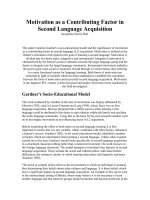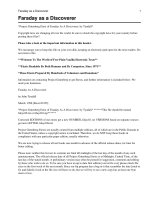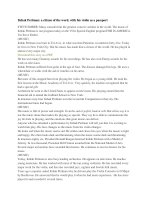introduction – imf as a financial institution
Bạn đang xem bản rút gọn của tài liệu. Xem và tải ngay bản đầy đủ của tài liệu tại đây (202.96 KB, 14 trang )
PART 1
INTRODUCTION – IMF AS A FINANCIAL INSTITUTION
1.1. General Introduction of IMF:
The International Monetary Fund is a cooperative international monetary
organization whose members currently include 183 countries of the world. It
was established together with the World Bank in 1945 as part of the Bretton
Woods conference convened in the aftermath of World War II.
Source: />The IMF is responsible for the creation and maintenance of the international
monetary system, the system by which international payments among countries
take place, strives to provide a systematic mechanism for foreign
Page 1
exchange transactions in order to foster investment and promote balanced global
economic trade.
To achieve these goals, the IMF focuses and advises on
the macroeconomic policies of a country, which affect its exchange rate and its
government's budget, money and credit management. The IMF will also
appraise a country's financial sector and its regulatory policies, as well as
structural policies within the macroeconomic that relate to the labor market and
employment. In addition, as a fund, it may offer financial assistance to nations
in need of correcting balance of payments discrepancies. The IMF is thus entrusted
with nurturing economic growth and maintaining high levels of employment
within countries.
IMF’s Organization Structure
Page 2
1.2. IMF’s Financial Resource:
Quota subscriptions generate most of the IMF's financial resources. The
size of each quota is determined by how much each government can pay
according to the size of its economy. The quota in turn determines the weight
each country has within the IMF - and hence it’s voting rights - as well as how
much financing it can receive from the IMF.
Twenty-five percent of each country's quota is paid in the form of special
drawing rights (SDRs), which are a claim on the freely usable currencies of
IMF members. Before SDRs, the Bretton Woods system had been based on a
fixed exchange rate, and it was feared that there would not be enough reserves
to finance global economic growth. Therefore, in 1968, the IMF created the
SDRs, which are a kind of international reserve asset.
The IMF does all of its accounting in SDRs, and commercial banks accept
SDR denominated accounts. The value of the SDR is adjusted daily against a
basket of currencies, which currently includes the U.S. dollar, the Japanese yen,
the euro, and the British pound.
If called upon by the IMF, a country can pay the rest of its quota in its local
currency. The IMF may also borrow funds, if necessary, under two separate
agreements with member countries.
Page 3
PART 2
THE ROLE OF IMF IN INTERNATIONAL FINANCE
2.1. Economic Surveillance:
The IMF considers whether domestic policies promote countries' own
stability by examining risks they might pose to domestic and balance of
payments stability and advising on needed policy adjustments. It also proposes
alternatives if countries' policies promote domestic stability, but could impact
global stability.
The IMF monitors the international finance through consulting with
member states.
The IMF monitors members’ economies through regular—usually annual—
consultations with each member country. During these consultations, IMF staff
discusses economic and financial developments and policies with national
policymakers, and often with representatives of business, labor unions, and
civil society. Consultations consider the impact of fiscal, monetary, financial,
and exchange rate policies on the member’s domestic and balance of payments
stability, as well as on global stability, and assess risks and vulnerabilities. The
IMF offers advice on policies to promote each country’s macro-financial and
balance of payments stability, drawing on experience across its membership.
The policy framework for these consultations is set in the Integrated
Surveillance Decision. These consultations are also informed by membership-
wide initiatives, including:
- Work to systematically assess countries' vulnerabilities to crises;
- The Financial Sector Assessment Program (FSAP). In collaboration with
the World Bank, the FSAP assesses countries’ financial sectors and helps
formulate policy responses to risks and vulnerabilities.
- The Standards and Codes Initiative. This joint IMF-World Bank initiative
assesses countries’ observance of a dozen internationally recognized
standards and codes of good practice to support the design and
implementation of related policies.
Page 4
- The IMF’s periodic reports on the World Economic Outlook, its regional
overviews, the Fiscal Monitor, and the Global Financial Stability Report
analyze global and regional macroeconomic and financial developments.
The key instruments of the IMF’s multilateral surveillance are two semi-
annual publications produced by the Fund – the World Economic Outlook
(WEO) and Global Financial Stability Report (GFSR). The WEO presents
IMF staff analyses of global economic developments during the near and
medium term. The GFSR focuses on current conditions in global financial
markets, highlighting issues that could pose a risk to financial market stability.
In addition, broad developments in multilateral exchange rates are reviewed
periodically by the Executive Board, e.g., through discussions of the WEO and
the GFSR and of exchange rate and financial market developments.
Finally, the IMF plays an important role in coordinating exit strategies from
extraordinary crisis-related measures.
For example, at the Pittsburgh, G-20 Summit leaders tasked the IMF and
FSB with assisting Finance Ministers in developing a plan for coordinated exit
strategies. The recent IMF WEO highlights the difficulty of coordinating exits.
Countries authorities must carefully time exit from accommodative policies so
that it is neither premature nor delayed. The optimal timing of exit will vary
with country circumstances, which could create cross-border spillovers that
will affect the global recovery. Substantive contributions from the IMF to this
difficult analytical problem are importantly needed.
2.2. Technical assistance and economic training
The IMF provides technical assistance and economic training in four
main areas:
- Monetary and financial policies:
• Regulating the interest rate cap for preference areas: agriculture, export,
small and medium enterprises, ancillary industries and the
high-tech sector.
• The stability of the exchange rate
Page 5
• Flexible management exchange rate and foreign exchange market
according to supply and demand of the market, the development of
international balance of payments.
• Monetary policy stance
• Flexible management and synchronization tools of monetary policy,
reserve management in accordance with the M2 and credit to achieve the
monetary targets, controlling credit growth.
- Fiscal policy and management:
• Tax and customs policies and administration, budget formulation,
expenditure management, design of social safety nets, and management of
domestic and foreign debt
Statistical data processing: Compilation, management, dissemination,
and improvement statistical data.
Advising on economic and financial legislation
• The Fund has undertaken a special responsibility for providing its
member countries with technical assistance and training in economic
management. Over the years, this assistance has become increasingly
important. In addition to this assistance, significant help has been given to
member countries by Fund staff member through training programs,
missions and the services of resident representatives.
• The types of assistance provided typically in the fields of central banking,
fiscal matters and economic and financial statistics reflect this link. The
stress on technical assistance in central banking matter, for instance, is
derived from the prime importance of monetary policy and properly
functioning financial systems in economic management.
• Similarly, advice on fiscal matters has always been a major activity
because, in the Fund’s experience, fiscal imbalances frequently play a
large part in balance of payments difficulties, while effective fiscal
management contributes significantly to balance of payments equilibrium.
Page 6
• Research, bank supervision, operations and foreign exchange
management and policy are at present the main focus of technical
assistance provided by the Central Banking Department. Other areas
include accounting, statistics, organization and training.
2.3. Loans to country’s with financial crisis:
2.3.1. Characteristics and purpose of IMF in solve crisis:
2.3.1.1. Some characteristics:
International Monetary Fund (IMF) is the world’s largest organization in
the field of finance and monetary has shown its role in nearly half a century
and has been active in bringing the crisis out of East Asia countries.
Operating fund of this organization is mainly due to the contribution of
members. However, in case of necessity, it may also borrow from the
international financial markets to supply loan fund (typically is the $300 billion
of debt). IMF also has a close collaboration with international banks for
reconstruction and development (especially International Bank for
Reconstruction and Development – IBRD) which was also established at the
Bretton Woods conference. IMF has set the lending limits and contributing
limits for members.
The criteria to determine the level of contribution is the potential of each
country’s position in the world economy.
2.3.1.2. Purpose:
IMF supports credit for member countries to deployment economic-social
development projects; overcome the deficit in international balance of
payment; solve the abnormal financial difficulties caused by nature or stabilize
the price of strategic materials and fuels; adjust the monetary relationship
between member countries.
The countries which want to borrow from IMF must prove that they will
use the money effectively. The borrowers must present to the IMF some
reforms to remove their recent difficulties, such as devalue their currency,
encourage exports and reduce government spending.
2.3.2. Monetary crisis in Asia in 1997 and some measures of IMF:
2.3.2.1. The summary of the crisis:
Page 7
- The context:
On July 1997, Thailand launched nearly 24 billion USD to keep the
price of Bath without success; Thailand was forced to float the Bath, starting
the first stage of crisis. This immediately has an impact on the currencies of
other countries in the region, from Malaysia, Philippine, Indonesia, Singapore
and then spread to Korea, Japan, and Hong Kong, Russia and even causes a
serious crisis on financial market of this country. The European and American
investors have diverted the investments from Asia to other countries with more
stable situation (capital pouring into Asia this time fell to 60 billion in 1997),
bankrupted a series of companies, the growth is negative and rising
unemployment.
- The causes:
The causes of this crisis is said to have no flexibility in the
implementation of exchange rate regime, so freedom in allowing the external
flow entering the investment channel, which makes the difference of exchange
rate. Also, in the early 90s, due to the difficult of market saturation, the
competitiveness is low, the Asia countries in turns declared to debt, especially
short-term debt, which needs international helps.
Page 8
Foreign debt and foreign- exchange reserves (end of 1997)
Unit: billion USD.
Nation Total debt
Short-term debt
(in total debt)
Foreign-
exchange
reserves
Thailand 91,7 65 27,0
Indonesia 137,4 60 16,6
Korea 154,4 70 20,4
Malaysia 44,1 55 21,7
In addition, the form of economic bubble at this time, the weakness of
the banking system with international speculation is also noticeable causes. The
speculation countries want to devalue the currencies of Asia countries to
enhance the value of dollar, creating favorable conditions for them.
2.3.2.2. Measures of IMF:
IMF has set a plan to help those countries with some criteria: resolutely
prevent the evasion of repaying foreign loans; restore fiscal balance, especially
budget balance; curb the increase of inflation; reestablishing and strengthening
foreign-exchange reserves; reform and improve the operating efficiency of the
banking system; remove the proprietary; declining output control.
To accomplish this goal, the IMF has provided a huge loan of 26 billion
SDRs, equivalent to 36 billion dollar for pioneering the amount of 77 billion
dollar from multilateral and bilateral sources to support this policy.
Besides financial assistance, IMF also help the three most affected
countries: Indonesia, Korea and Thailand by arranging plans to reform
economic to eliminate the cause of payment difficulties, prevent the spread of
crisis and find the remedies, preparing the foundation for economic growth.
According to IMF, the main cause of balance of payment deficits are mostly
due to monetary demand, and the cost of production and price of goods and
services of countries are not fit together. Thus to overcome this, IMF requires
countries to implement two methods: the first is to reduce the total demand of
money thanks to monetary-credit policy and budget management. The second
is currency devaluation or floating mode.
2.3.2.3. Assess the role of IMF in crisis:
Page 9
IMF paves the way for investment activities and financial aid from financial
institution as well as other countries. It also plays a mediating role of solving
the crisis, standing out for settling solutions to countries which has crisis the
ability to borrow the amount of 117 billion dollar.
The financial aid of IMF has a role of preventing the spread of crisis and the
decline of economy of many Asia countries. Signs of recovery appeared in
April 1999 showed that the financial crisis which lasted 21 months now has
some optimistic views.
In addition, IMF also proposed appropriate measures to reform the
economy and financial structure for a sustainable development in the future.
2.4. SDR mechanism:
2.4.1. Definition:
The Special Drawing Right (SDR) is an interest-bearing international
reserve asset created by the IMF in 1969 to supplement other reserve assets of
member countries.
The SDR is based on a basket of international currencies comprising the
U.S. dollar, Japanese yen, euro and pound sterling. It is not a currency, nor a
claim on the IMF, but is potentially a claim on freely usable currencies
of IMF members.
The value of the SDR is not directly determined by supply and demand in
the market, but is set daily by the IMF on the basis of market exchange rates
between the currencies included in the SDR basket.
It can be held and used by member countries, the IMF, and certain
designated official entities called "prescribed holders"—but it cannot be held,
for example, by private entities or individuals. The SDR also serves as the unit
of account of the IMF and some other international organizations.
2.4.2. General SDR allocation:
An SDR allocation is a low cost way of adding to members' international
reserves, allowing members to reduce their reliance on more expensive
domestic or external debt for building reserves.
Page 10
Each member country is assigned a certain amount of SDRs based on how
much the country contributes to the Fund (which is based on the size of the
country's economy). The need for SDRs lessened when major economies
dropped the fixed exchange rate and opted for floating rates instead.
The larger the country, the larger its contribution; thus the U.S. contributes
about 18% of total quotas while the Seychelles Islands contribute a
modest 0.004%.
The IMF has the authority under its Articles of Agreement to create
unconditional liquidity through "general allocations" of SDRs to participants in
its SDR Department in proportion to their quotas in the IMF.
General allocations of SDRs should meet a long-term global need to
supplement existing reserve assets in a manner that will promote the attainment
of the IMF's purposes and avoid economic stagnation and deflation, as well as
excess demand and inflation.
2.4.3. The role of SDR:
The SDR was created by the IMF in 1969 to support the Bretton Woods
fixed exchange rate system.
Rather, it is a potential claim on the freely usable currencies of IMF
members. Holders of SDRs can obtain these currencies in exchange for their
SDRs in two ways: first, through the arrangement of voluntary exchanges
between members; and second, by the IMF designating members with strong
external positions to purchase SDRs from members with weak external
positions. In addition to its role as a supplementary reserve asset, the SDR
serves as the unit of account of the IMF and some other international
organizations.
An important role, being the unit of account for the IMF has long been the
main function of the SDR.
2.4.4. Value of SDR:
Initially, the value of the SDR was defined in terms of one US – $, which in
turn was defined in terms of an ounce of gold.
Thursday, March 27, 2014
Page 11
Currency
Currency
amount under
Rule O-1
Exchange
rate
1
U.S. dollar
equivalent
Percent change in
exchange rate against
U.S. dollar from
previous calculation
Euro 0.4230 1.37650 0.582260 -0.181
Japanese yen 12.1000 102.36000 0.118210 0.020
Pound sterling 0.1110 1.66370 0.184671 0.550
U.S. dollar 0.6600 1.00000 0.660000
1.545141
U.S.$1.00 = SDR 0.647190
2
0.002
3
SDR1 = US$ 1.54514
4
Source: IMF, Finance Department
Page 12
Actual value:
• The exchange rate of 2 April 2013 was 1 SDR = 1.50125 USD.
• Average relation between SDR and USD has been, yearly 2004-2012:
2.4.5. H
ol
d
er
s
of
SDRs:
All IMF members have chosen to participate in the SDR Department.
Participants receive allocations of SDRs, and only participants, the IMF, and
prescribed official entities may hold or use SDRs. There are currently 15
prescribed official holders.
The IMF and prescribed holders acquire and use SDRs through
transactions with participants and with each other. The IMF receives and
disburses SDRs in transactions conducted through the GRA, and holds SDRs in
the GRA.
Sources of IMF holdings include quota subscriptions, repurchases, interest
on loans to members and on GRA holdings, and re-imbursements for the cost
of conducting the business of the SDR Department. Uses of SDRs by the IMF
include purchases, remuneration on members’ creditor.
REFERENCE
Page 13
Year SDR/USD Year SDR/USD
2004 1.48147 2009 1.54195
2005 1.47714 2010 1.52542
2006 1.47150 2011 1.57941
2007 1.53085 2012 1.53145
2008 1.58129
Total average 1.52450
1. Website:
- />- />- />- />- />2. Book & Economic Research
- “International Monetary Fund Handbook”, Bernhard Fritz – Krockow
Parmeshwar Ramlogan, January 2007.
- “The role of IMF and WB in solving global financial crisis”, Izet Ibreljić,
Amra Kožarić, Faculty of Economics, Tuzla, Univerzitetska 8, Bosnia and
Herzegovina
Page 14









